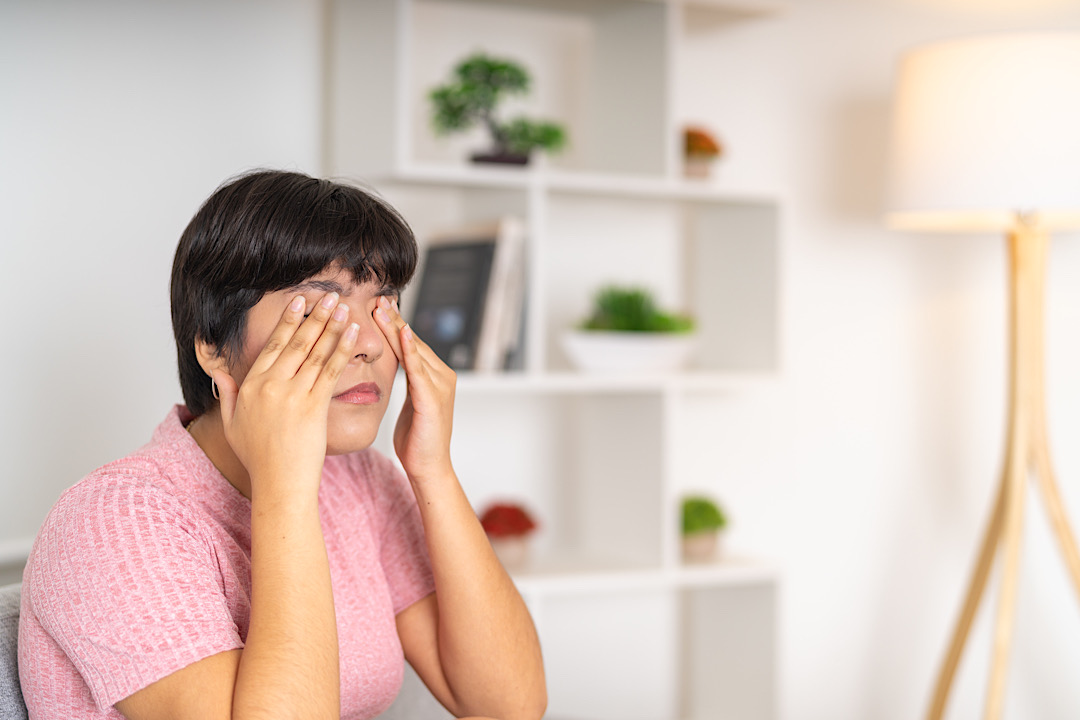The Surprising Causes of Dry Eyes You Need To Know

Today about 16 million Americans have dry eye disease, which is more common in women than men, especially in those of us over 50—about the age when I started noticing symptoms. Approximately 90 percent of dry eye cases are due to dysfunction of the eyelids’ oil glands (known as meibomian glands) that cause oil secretions to become too thick or hard to reach the eye surface. Oil is an essential component of tears and without adequate oil, tears evaporate too quickly, and the eye surface becomes dry and inflamed leading to symptoms of dry eye disease like blurry vision, feeling of a foreign object in the eyes, light sensitivity, and burning, stinging, or redness, says Cheryl Chapman, OD, an optometrist based in Nebraska who specializes in dry eye disease.
The reason women in midlife are prone to dry eye is the double whammy of age-related changes in tear production and riding on a hormonal roller coaster. “Hormonal fluctuations, particularly in women during menopause, can lead to changes in tear production and composition making them more susceptible to dry eye,” says Dr. Chapman. (You might notice dry skin on eyelids, too.)
But that doesn’t mean younger adults don’t need to have the signs, symptoms, and causes of dry eyes on their radar—in fact, the number of dry eye cases has surged in all age groups in the past decade or so as other common causes of the disease become more widespread. Those causes, says Dr. Chapman, include long stretches of screen time—staring at screens reduces the frequency of blinking, contributing to dry eye symptoms—environmental conditions including air pollution and dry indoor air, and certain medical conditions such as diabetes, autoimmune diseases, and thyroid disorders.
“The use of medications with dry eye as a side effect has also become more prevalent,” says Dr. Chapman. “Antihistamines, decongestants, antidepressants, blood pressure medications, and acne medications such as Accutane are some examples.” Even popular cosmetic procedures like Botox injections can disrupt normal tear film production and lead to dry eye, she adds.
How to prevent dry eye disease
Dry eye can have a gradual onset, and sometimes symptoms aren’t noticed until damage has already occurred, so the best bet is to prevent the disease in the first place. The best way to do that is through practicing eyelid hygiene (something I wish I’d known 20 years ago) to help the eye’s oil glands function properly, advises Dr. Chapman. Think of it as the eyelid equivalent of brushing your teeth to prevent cavities from occurring down the road.
“Eyelid hygiene is a set of practices aimed at maintaining the cleanliness and health of the eyelids and the surrounding areas,” says Dr. Chapman, who is the co-founder of Peeq Pro, a direct-to-patient subscription program with products designed to make eyelid hygiene more accessible. “Proper eyelid hygiene is essential for overall eye health and can play a crucial role in preventing and managing dry eye syndrome. Eyelid hygiene is an important component of the overall management of dry eye, especially when meibomian gland dysfunction and inflammation of the eyelids, or blepharitis, are contributing factors to the condition.”
Dr. Chapman’s tips for a good eyelid hygiene routine
- Clean your eyelids regularly to remove debris, oils, and bacteria. (Dr. Chapman recommends using hypochlorous solutions, Peeq Pro Eyelid & Facial Cleanser, or the Peeq Pro Waiva Eyelid Cleaning Kit)
- Apply warm compresses to the eyelids to soften oil secretions and prevent tear evaporation
- Massage the eyelids with warm compresses to help express and move oil gland secretions
- Remove eye makeup properly and gently, and avoid using harsh cleansers around the eyes
What to do if you’ve been diagnosed with dry eyes
Although I wish I’d known about dry eye prevention before I developed the condition, now I’ll be making sure to do my best to keep the disease in a holding pattern by making eyelid care as regular a part of my daily routine as brushing my teeth and washing my face because left untreated, dry eye can lead to infections, decreased vision, and corneal damage or scarring.
“Dry eye is typically a chronic condition, and it may not have a permanent cure in the traditional sense,” she says. “However, the symptoms and discomfort associated with dry eye can often be managed effectively, and the condition’s progression can be slowed or even halted in some cases. The goal of treatment is to alleviate symptoms, improve tear film quality, and enhance overall eye health.”
Dry eye is easily diagnosed by an eye doctor during an exam. They can also discuss additional therapies including artificial tears, prescription medications, and in-office treatments to unclog the oil glands.
Well+Good articles reference scientific, reliable, recent, robust studies to back up the information we share. You can trust us along your wellness journey.
-
Reza, Dana et. al. Estimated Prevalence and Incidence of Dry Eye Disease Based on Coding Analysis of a Large, All-age United States Health Care System. vol. 202, American Journal of Opthamology, 2019,
Our editors independently select these products. Making a purchase through our links may earn Well+Good a commission.
link


:max_bytes(150000):strip_icc()/GettyImages-557136101-56a9cff33df78cf772aab5f3.jpg)
:max_bytes(150000):strip_icc()/dry-eyes-in-winter-5210786-No-Text-Final-58196281b6f846f3a5a026772b9a056c.jpg)



